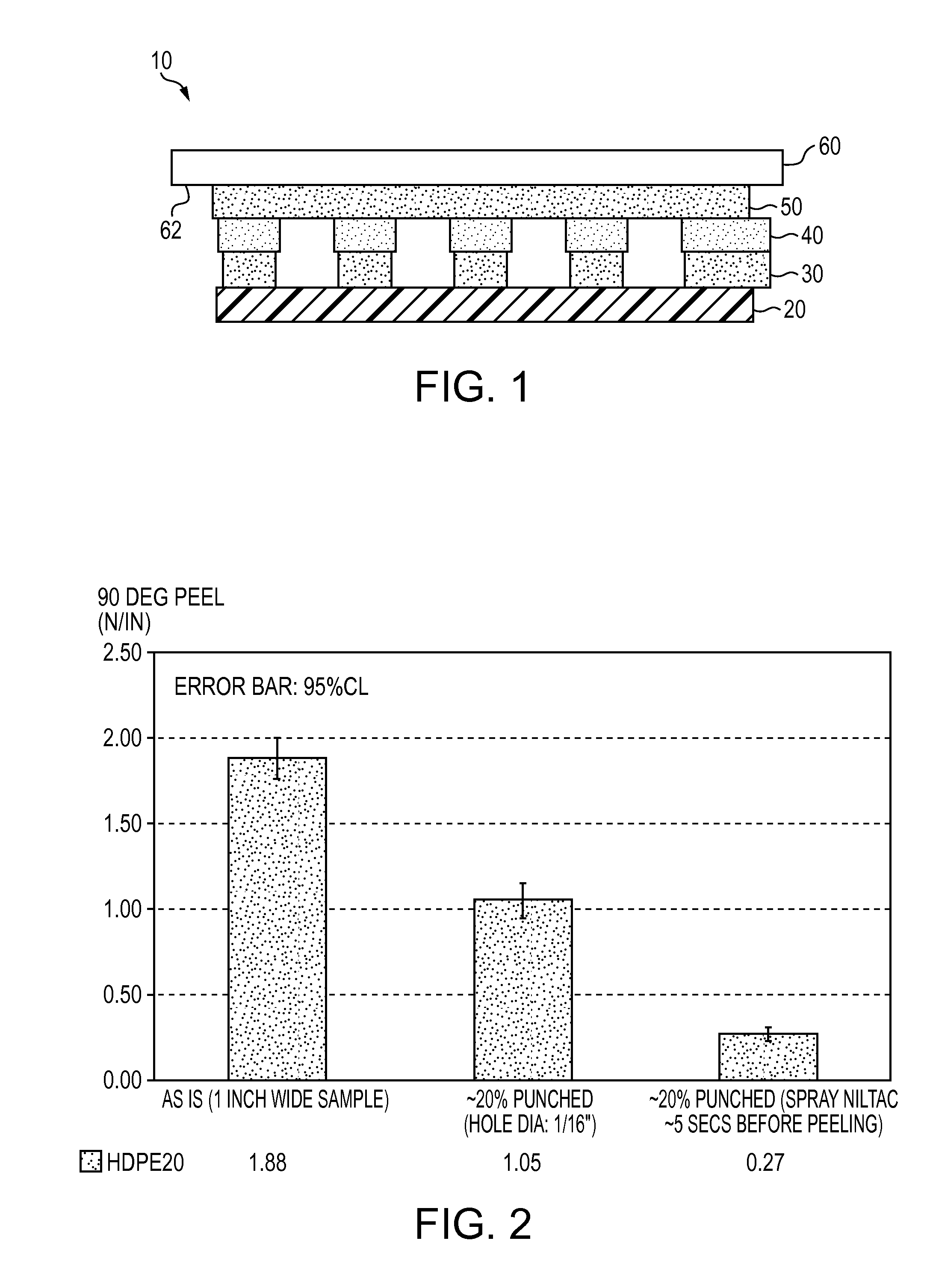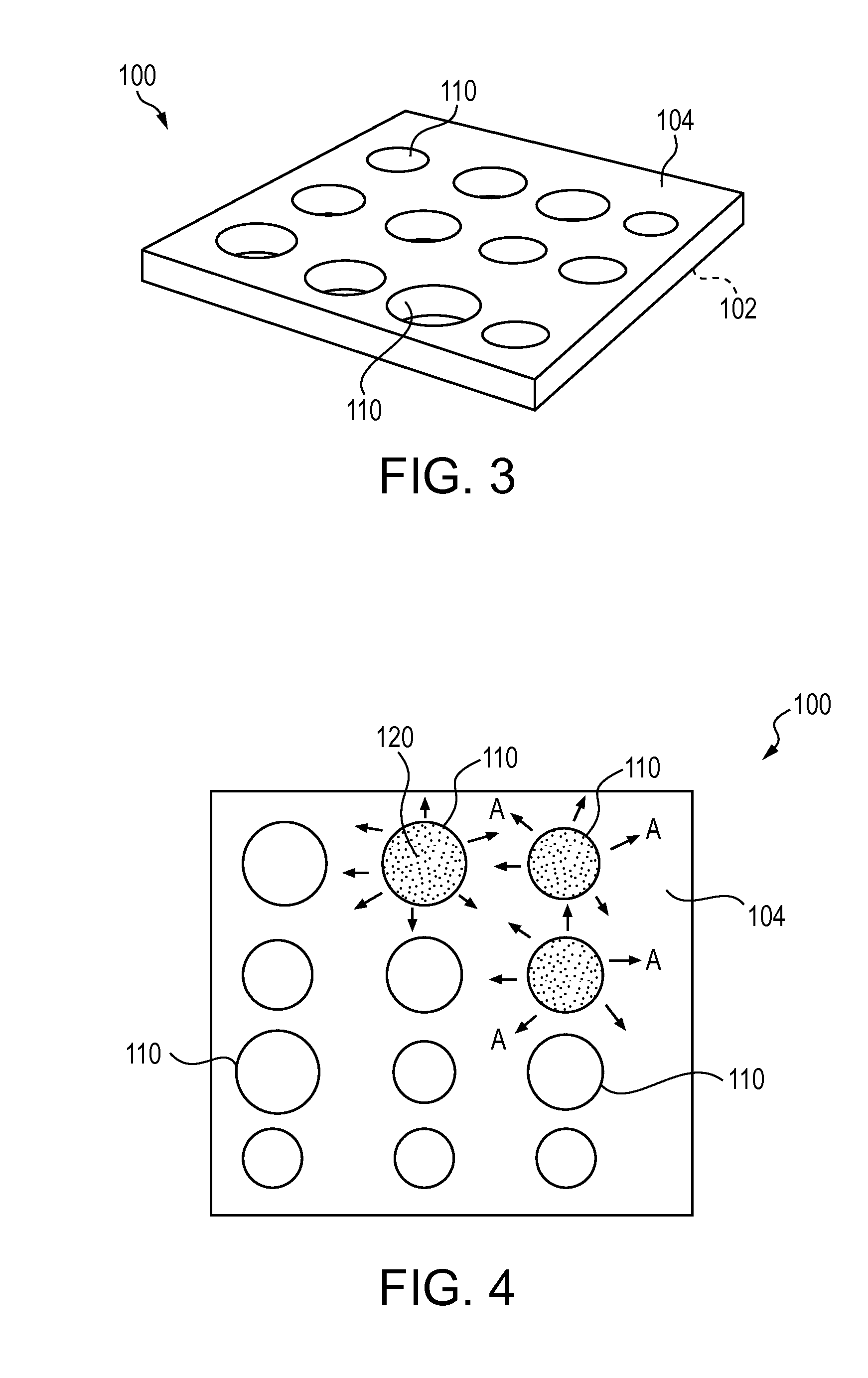Systems, Methods and Materials for Delivery and Debonding on Demand
a technology of adhesive debonding and delivery system, applied in the field of adhesive adhesive adhesive articles, can solve the problems of difficult to meet the needs of customers, difficult to remove adhesive adhesives, and difficult to achieve the effects of reducing the number of adhesives, and reducing the difficulty of adhesive debonding
- Summary
- Abstract
- Description
- Claims
- Application Information
AI Technical Summary
Benefits of technology
Problems solved by technology
Method used
Image
Examples
example 1
[0095]An adhesively coated commercial product available from the present assignee under the designation “I-1827A” production laminate (a breathable transparent polyurethane (PU) film), was manually punched with approximately 63 perforations (average diameter of 1 / 16 inch) per square inch representing a removal of approximately 20% of the adhesive. FIG. 2 shows that the measured room temperature 90° peel adhesion on high density polyethylene (HDPE) substrates decreases to about 1 N / in2 as compared to its original value of 1.9 N / in2 when left non-perforated. When the laminate is sprayed with hexamethyldisiloxane (HMDS) and immediately, or at least within about 15 seconds, peeled, while still wet, the measured adhesion precipitously drops to approximately 0.3 N / in2. The peel adhesion quickly restores back to about 1 N / in2 if the peel measurement is made after the laminate is allowed to completely dry. Similarly, when using Nitac™ TR101, a “sting-free” medical adhesive remover available...
example 2
[0127]Vacuum assisted closure (VAC) drape dressings typically need to be optically clear and conformable with ability to hold negative pressures. FIG. 7 depicts another preferred embodiment that can afford “ouchless” debonding on demand. Specifically, the embodiment 300 comprises a central region 310 for placement over a wound and a vacuum air seal overlaminate. The outer region 320 of the embodiment 300 may correspond to the preferred embodiment laminates described herein. The drape dressing comprises the previously noted I-1827A production laminate available from the present assignee that is appropriately perforated for promoting initial adhesion and selective debonding performance. Once this perforated laminate is applied over the foam clad wound area resulting from treatment in accordance with VAC techniques, another nonpervious overlaminate is applied on top to ensure that the area is sealed to adequately maintain the required negative pressure therapy, optimum moisture vapor t...
example 3
[0133]Another embodiment of the invention that extends this concept, additionally utilizes a peri-wound covering that is attached to an area surrounding a wound. This provides the surface to which products such as a vacuum assist closure (VAC) therapy film are adhered. Since the adhesive in these products does not directly contact the skin, one can further minimize the pain, allergy, etc. that is inflicted by their repeated use of bonding and debonding from the upper surface of the pen-wound covering. The pen-wound pseudo-skin shield can be designed to stay securely attached to the skin for times significantly longer than typical medical dressings. Since the present invention can be used for eventual atraumatic removal, this may offer significant advantages to the nurse or patient.
[0134]The material used in such pseudo-periskin shields can alternatively be designed to be selectively destructed, on demand, using selective adhesive debonding strategies. Referring to FIG. 11 for exampl...
PUM
| Property | Measurement | Unit |
|---|---|---|
| Diameter | aaaaa | aaaaa |
| Diameter | aaaaa | aaaaa |
| Diameter | aaaaa | aaaaa |
Abstract
Description
Claims
Application Information
 Login to View More
Login to View More - R&D
- Intellectual Property
- Life Sciences
- Materials
- Tech Scout
- Unparalleled Data Quality
- Higher Quality Content
- 60% Fewer Hallucinations
Browse by: Latest US Patents, China's latest patents, Technical Efficacy Thesaurus, Application Domain, Technology Topic, Popular Technical Reports.
© 2025 PatSnap. All rights reserved.Legal|Privacy policy|Modern Slavery Act Transparency Statement|Sitemap|About US| Contact US: help@patsnap.com



